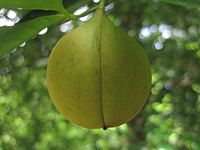Contents
Myristic acid (IUPAC name: tetradecanoic acid) is a common saturated fatty acid with the molecular formula CH3(CH2)12COOH. Its salts and esters are commonly referred to as myristates or tetradecanoates. The name of the acyl group derived from myristic acid is myristoyl or tetradecanoyl. The acid is named after the binomial name for nutmeg (Myristica fragrans), from which it was first isolated in 1841 by Lyon Playfair.[12]
Occurrence

Nutmeg butter has 75% trimyristin, the triglyceride of myristic acid and a source from which it can be synthesised.[13] Besides nutmeg, myristic acid is found in palm kernel oil, coconut oil, butterfat, 8–14% of bovine milk, and 8.6% of breast milk as well as being a minor component of many other animal fats.[9] It is found in spermaceti, the crystallized fraction of oil from the sperm whale. It is also found in the rhizomes of the Iris, including Orris root.[14][15]
Chemical behaviour
Myristic acid acts as a lipid anchor in biomembranes.[16]
Reduction of myristic acid yields myristyl aldehyde and myristyl alcohol.
Health effects
Myristic acid consumption raises low-density lipoprotein (LDL) cholesterol.[17][18]
See also
References
- ^ Merck Index, 11th Edition, 6246
- ^ a b c d Bond, Andrew D. (2003). "On the crystal structures and melting point alternation of the n-alkyl carboxylic acids" (PDF). RSC.org. Royal Society of Chemistry. Retrieved 17 June 2014.
- ^ a b Chuah, T.G.; Rozanna, D.; Salmiah, A.; Thomas, Choong S.Y.; Sa’ari, M. (2006). "Fatty Acids used as Phase Change Materials (PCMs) for Thermal Energy Storage in Building Material Applications" (PDF). University Putra Malaysia. Retrieved 17 June 2014.
- ^ a b c d e f g Lide, David R., ed. (2009). CRC Handbook of Chemistry and Physics (90th ed.). Boca Raton, Florida: CRC Press. ISBN 978-1-4200-9084-0.
- ^ a b c d e f g Seidell, Atherton; Linke, William F. (1940). Solubilities of Inorganic and Organic Compounds (3rd ed.). New York: D. Van Nostrand Company. pp. 762–763.
- ^ a b c d Tetradecanoic acid in Linstrom, Peter J.; Mallard, William G. (eds.); NIST Chemistry WebBook, NIST Standard Reference Database Number 69, National Institute of Standards and Technology, Gaithersburg (MD)
- ^ Vargaftik, Natan B.; et al. (1993). Handbook of Thermal Conductivity of Liquids and Gases (illustrated ed.). CRC Press. p. 305. ISBN 978-0-8493-9345-7.
- ^ Yaws, Carl L. (2009). Transport Properties of Chemicals and Hydrocarbons. New York: William Andrew Inc. p. 177. ISBN 978-0-8155-2039-9.
- ^ a b Beare-Rogers, J.L.; Dieffenbacher, A.; Holm, J.V. (2001). "Lexicon of lipid nutrition (IUPAC Technical Report)". Pure and Applied Chemistry. 73 (4): 685–744. doi:10.1351/pac200173040685. S2CID 84492006.
- ^ a b Sigma-Aldrich Co., Myristic acid.
- ^ a b c "Myristic Acid". ChemicalLand21.com. AroKor Holdings Inc. Retrieved 17 June 2014.
- ^ Playfair, Lyon (2009). "XX. On a new fat acid in the butter of nutmegs". Philosophical Magazine. Series 3. 18 (115): 102–113. doi:10.1080/14786444108650255. ISSN 1941-5966.
- ^ Beal, G. D. (1926). "Myristic Acid". Organic Syntheses. 6: 66. doi:10.15227/orgsyn.006.0066.
- ^ Council of Europe, August 2007 Natural Sources of Flavourings, Volume 2, p. 103, at Google Books
- ^ John Charles Sawer Odorographia a natural history of raw materials and drugs used in the perfume industry intended to serve growers, manufacturers and consumers, p. 108, at Google Books
- ^ Cox, David L. Nelson, Michael M. (2005). Lehninger principles of biochemistry (4th ed.). New York: W.H. Freeman. ISBN 978-0716743392.
{{cite book}}: CS1 maint: multiple names: authors list (link) - ^ Mensink, Ronald P. (2016). "Effects of saturated fatty acids on serum lipids and lipoproteins: a systematic review and regression analysis" (PDF). World Health Organization.
- ^ Schwingshackl L, Bogensberger B, Benčič A, Knüppel S, Boeing H, Hoffmann G (2018). "Effects of oils and solid fats on blood lipids: a systematic review and network meta-analysis". J Lipid Res. 59 (9): 1771–1782. doi:10.1194/jlr.P085522. PMC 6121943. PMID 30006369.

